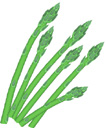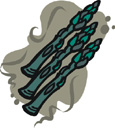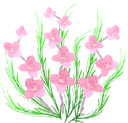
Asparagus are a vegetable of the liliaceaea (lily) family).
- botanical information
- origin
- history
- nutritional information
- selection
- storage
- health care
- Chinese herbology
- Ayurvedic herbalism
botanical information:
Botanical name: Asparagus officinalis
Common name: asparagus, sparrowgrass
French name: asperge
Use the botanical name when ordering seeds (bulbs, etc.) or when looking up information in the library. Common names vary by nation, culture, and region, and sometimes the same common name is applied to different plants.
Family: Liliaceae (lily)
Asparagaceae (asparagus) — the modern taxonomy separates the asparagus family from the larger lily family.
origin:
Origin: Mediterranean.
history:
History: Asparagus was banned from girls’ schools by 19th century nuns who feared its phallic shape would lead to promiscuity.
nutritional information:
Eat at least one serving of asparagus per month, taking in account the season and local availability. For more information on healthy diet, see Goddess Diet Plan.
Asparagus is an alkaline-producing food (measured by the ash content resulting from laboratory titration.
Asparagus is a source of protein.
Asparagus is a food that increases sexual energy and enhances fertility.
nutritional value of green asparagus:
- high in Vitamin A
- high in Vitamin C
- high in folic acid
- high in fibre
Green asparagus has more nutrients than white asparagus. The darker the color, the more nutrients. White aspargus has more sugar (and is therefore sweeter tasting).
See also Chinese herbalism below for Chinese gender and Chinese flavor.
selection:
Asparagus has the number seven (7) lowest pesticide load of 45 common fruits and vegetables studied in 2006 by the Environmental Working Group and is therefore a food that can be purchased conventionally-grown when organic isn“t available. The EWA explains, “While washing and rinsing fresh produce may reduce levels of some pesticides, it does not eliminate them. Peeling also reduces exposures, but valuable nutrients often go down the drain with the peel. The best option is to eat a varied diet, wash all produce, and choose organic when possible to reduce exposure to potentially harmful chemicals.”
According to USDA and FDA tests on commercially grown foods collected between 2000 and 2005, asparagus has a 6.7% (percentage) of samples tested with detectable pesticides, a 0.6% (percentage) of samples with two or more pesticides, an 0.1 average number of pesticides found in a sample, an average of 0.026 parts per million of all pesticides found, and 19 different pesticides found in use growing asparagus. These toxic pesticides don’t apply to organic foods.
storage:
Storage: Eat asparagus within two days of purchase.











health care uses:
Health Notice: Attempting to be an amateur doctor is potentially dangerous to your health. This web page is not professional medical advice. Nothing on this website should be considered as a substitute or replacement for professional medical advice. Persons should seek the advice of qualified health providers. Self-medication should not be used as a substitute for professional medical care. Please confirm all self-medication with your doctor or health care professional. See the article on healing for recommended healers.
Chinese herbalism:
Chinese gender: yin (cool)
Chinese flavor: slightly sweet
Ayurvedic herbalism:
Ayurvedic Doshas: PK- Vo Pitta decreases; Kapha decreases; Vata mixed
For more information, see the article on Ayurvedic medicine.
next food
herbs |
||
| previous plant |
next plant |














